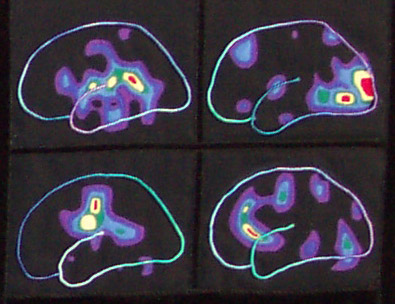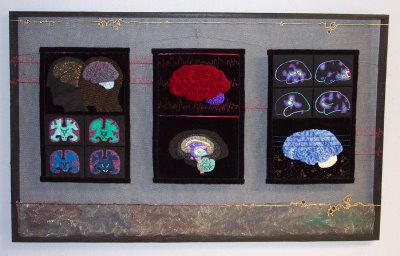Interview With "Fabric Brain Artist" Marjorie Taylor
Marjorie Taylor is a professor and department head in Psychology at the University of Oregon. I first encountered her "Museum of Scientifically Accurate Fabric Brain Art" after it got the Boing Boing treatment about two weeks ago. I thought they were interesting enough to hassle Taylor for an email interview. Fascinating stuff!
 Fabric brain art by Marjorie Taylor (detail)
Fabric brain art by Marjorie Taylor (detail)TiP: What first inspired you to create these quilts?
Taylor: I like to work with fabrics and have made about 30 quilts, as well as other projects involving fabric (hooked rugs, needle point, etc.). I like fine detail and enjoy using tiny beads, metallic threads - whatever - to create effects. When people in my department started using brain imaging techniques, I was immediately struck by the beauty of fMRI, PET, and ERPs. I like visual art influenced by scientific images and I thought the folds of the cerebral cortex would look great in velvet.
 TiP: Describe the techniques you have used. Quilting, beading, embroidery? Are these present in different combinations in each work? Other craft skills?
TiP: Describe the techniques you have used. Quilting, beading, embroidery? Are these present in different combinations in each work? Other craft skills?Taylor: I use both hand and machine quilting, embroidery, beading, applique and reverse applique. I use the patterns on computer boards as inspirations for quilt lines and electronic pieces (resistors, etc.), as well as different types of beads, as decoration. I particularly like to use tiny mirror pieces because it suggests mirror neurons. The materials are tulle, velvet, silks, satins, cottons, metal netting, and lots of different kinds of decorative threads. Lately, I have been incorporating old computer pieces (core memory) into the designs. Plus I like the look of circuitry diagrams in old texts and use them as well.
TiP: Do you do a lot of crafts, or did you learn these skills in order to do this project?
Taylor: I have always liked to make things.
TiP: What does it mean to you to interpret scientific research through such a traditional craft?
Taylor: It strikes me as funny.
TiP: There seems to be a form of meditation at work here, given that quilting, embroidery, etc. are relatively slow processes, while PET scanning, film development, and even interpretation of individual images are all relatively rapid processes. Is there anything else in your work that offers a comparable intensity of attention, for lack of a better descriptor? Any other thoughts on this?
Taylor: It is true that my pieces sometimes take a very long time. The first one took months because I did not know how to cut the velvet and fold it to make an anatomically correct brain. I made several before I was satistifed with the result. You are right that the process is meditative. It is calming to make fabric brains.
TiP: What are the stories behind the images of your work on the website? Do they reflect particularly interesting brain events or situations, or are they "normal" scans?
Taylor: One of them is based on a scan of the brain of one of the scientists working at the Lewis Center for Neuroimaging at the University of Oregon. I wanted to do a piece with a particular view so I went down to the center and Mark Dow gave me a scan of his brain that I cut up and used as a pattern. In other pieces, I have used scans from published articles in scientific journals. For example, one piece (done in reverse applique) shows PETs for hearing words, readings words, etc.
TiP: Do any of the scans you have recreated come from still-living subjects? If so, have these subjects seen them? What is their relationship to the work?
Taylor: The piece that is based on Mark Dow's brain is hanging in the waiting room of the imaging center where he works. He likes it.








No comments:
Post a Comment